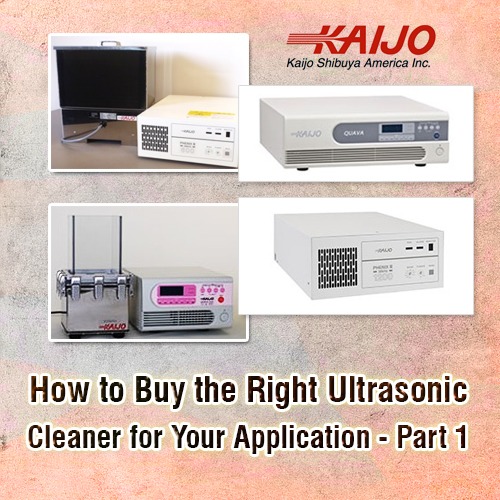How to Buy the Right Ultrasonic Cleaner for Your Application – Part I
July 30, 2018
 Industrial ultrasonic cleaners can clean parts quickly and completely if they have the right characteristics for the application. Ultrasonic cleaning systems are made up of a generator, one or more transducers, and a cleaning tank. Each component has to be selected correctly and they have to work together for the system to live up to its cleaning potential. Systems can be designed to clean one kind of part or they can be flexible and clean many different kinds. The key to selecting the right system is to be clear about what cleaning has to be done and what the required result should be.
Industrial ultrasonic cleaners can clean parts quickly and completely if they have the right characteristics for the application. Ultrasonic cleaning systems are made up of a generator, one or more transducers, and a cleaning tank. Each component has to be selected correctly and they have to work together for the system to live up to its cleaning potential. Systems can be designed to clean one kind of part or they can be flexible and clean many different kinds. The key to selecting the right system is to be clear about what cleaning has to be done and what the required result should be.
The Cleaning Application
Cleaning parts effectively depends on the kind of part that has to be cleaned and the type of contaminants that are on the parts. When the right industrial ultrasonic cleaner is used, the surfaces of the parts to be cleaned are unaffected while the substances that have to be removed are washed away quickly. Ultrasonic cleaners remove light contamination such as dust, films and residue quickly and completely, even when the parts are odd shapes or have holes, cracks and crevices. The ultrasonic cleaners act wherever the cleaning solution can penetrate so interior cavities are also cleaned as long as the cleaning solution can enter.
When contamination is heavy, additional measures may be appropriate. For thick deposits of oil or grease, heating the cleaning solution helps speed cleaning because the oil and grease become softer and easier to remove. For some difficult deposits, mild solvents that act on the contaminant may also help clean the parts. If a cleaning application falls into these categories, the ultrasonic cleaning system should be able to handle solvents and heat the cleaning solution.
Size and Power
The size of the parts to be cleaned determines the cleaning tank size and influences the power required for the industrial ultrasonic cleaner. For unusually shaped parts, such as long thin parts or large flat ones, a custom tank may be appropriate to avoid having to power a large amount of cleaning solution, most of which is empty. In any case, the tank has to be slightly larger than the longest dimension of the parts to be cleaned.
Larger tanks will need more power but the most important factor is that the ultrasonic waves have to be evenly distributed and reach all sections of the cleaning tank. Too much power may cause pitting on the surfaces of the parts so buying a system with the right power is important. A competent manufacturer can help select the required power levels or recommend a system for which the power level is adjustable, depending on the cleaning application.
How to Immerse the Parts to be Cleaned
Since ultrasonic cleaning is carried out by means of high-frequency sound waves in the cleaning solution, both the tank walls and the parts to be cleaned may vibrate slightly as cleaning takes place. This means parts must be suspended in the cleaning solution to avoid contact between the parts and the tank walls or bottom because the vibrations can cause damage.
A basket that fits inside the tank can hold the parts safely suspended in the cleaning solution but the cleaning tank will have to be slightly larger to accommodate the basket. Baskets are usually stainless steel but they can be coated to hold delicate parts without scratching.
Kaijo’s Experts can Provide Help
With extensive experience in industrial ultrasonic cleaning systems, Kaijo can help customers select the ultrasonic cleaner best suited to their needs. Kaijo will provide free consultation on size, power, baskets as well as the appropriate frequency to use for a given cleaning application. They offer an extensive product line of ultrasonic cleaning equipment to address the needs of many different kinds of industrial cleaning applications.





